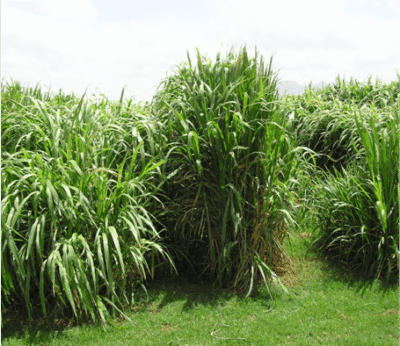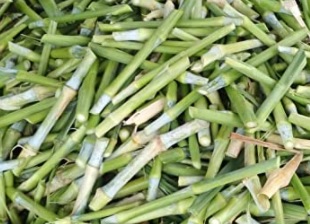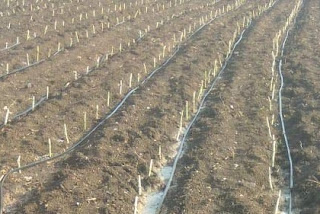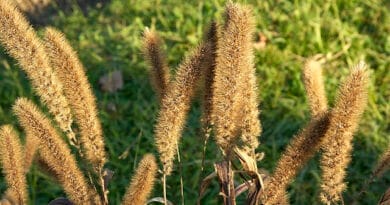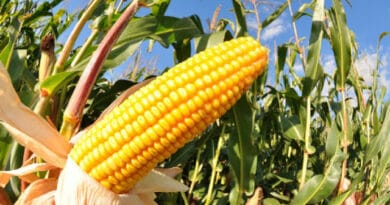Cultivation of Hybrid Napier Grass for Cattle Feeds; A Full Guide of Information
Cultivation of Hybrid Napier Grass: An excellent fodder crop due to its high yield, nutritional content, and year-round availability of green fodder.
Napier grass, or elephant grass (Pennisetum purpureum Schum) belongs to the family Poaceae (alt. Gramineae). It is a perennial grass that provides palatable green fodder year-round; it is also known as Uganda grass and is used for haymaking. This grass is too coarse, but it can also be used for silage-making.
A combination of Napier grass with lucerne or cowpea provides good-quality, palatable fodder for cattle. Napier is considered a soil-restoring crop as grass leaves the soil richer organic matter
Napier grass is a tall perennial grass growing to a height of 150 to 200 centimeters. It is similar to sugarcane in habit of growth in clumps of 20 to 30 stalks. The plant tillers profusely. When fully grown, the stems are reed-like. The lower part of the stem is usually smooth, and the portion near the top is usually hairy. The leaves are dull green and long, growing to about 90 centimeters.
Nutritive Value of Napier Grass ;
Required Climatic Conditions for Napier Grass Cultivation:
Important Varieties of Napier Grass:
Varieties | Suitable for the Regions |
Central India, North East Hills, and Northern Hills | IGFRI Hybrid Napier – 3 |
Whole Country | Pusa Giant & NB -21 |
Tamil Nadu, Karnataka, AP, and Gujrat | Co-1, Co-2 ,Co-3 ,Co-5 |
Hilly, Sub-Humid, and Sub-Temperate India | IGFRI-7 |
Punjab | PBN – 83 |
Whole Country | IGFR- 10 |
Super Napier Grass;
This is an interspecific hybrid between Napier grass (Pennisetum purpureum) and Bajra (Pennisetum typhoides). It is widely known as the Bajra-Napier Hybrid. Napier is a perennial grass that can be retained in the field for 2-3 years.
Comparison Between Napier Grass and Super Napier Grass;
Characteristics | Napier grass | Super Napier Grass |
Height after 60 Days of Sowing | 6 ft | 10 ft |
First Harvest | 90 – 120 days | 90 days |
Days Till Every Succeeding Harvest | 42-56 days for Animal Feeding 60-90 days (4-6 times a year) | 45-60 days for animal feeding 3-4 months for energy |
Crude Protein % at First Harvest | 8 – 12 % | 16- 18% |
Cow to Hectare Ratio | 8:1 | 50:1 |
Fresh Yield/Hac | 300 – 400 tons per Ha | 570 tons per ha |
Dry Matter Yield/year | 40 tons/Ha | 140 tons per Ha |
Crop Rotations and Mixed Cropping
The following cropping patterns involving hybrid Napier are widely used for a wide range of climatic conditions.
Field Preparation for Napier Grass Cultivation
The land should be prepared well and free from weeds. A good seedbed that is firm and well-leveled is required for planting Napier grass. Give the first ploughing with a mold-board plough and the subsequent two ploughings with a cultivator or harrow. Planking should follow every ploughing.
Seed and Sowing of Napier Grass;
a) Sowing Time A well-prepared seedbed with adequate moisture is essential for its establishment at the end of February or March. The Best Time for sowing is between 15 February and 15 March
Both stem and root cuttings are used for their propagation. When stem cutting is used for planting, it must have two or three nodes with potent buds. It should be planted with a spacing of 90 x 60 centimeters. One bud is buried underground for the sprouting of roots, and the rest, one or two, are kept at and above ground level for the sprouting of shoots. When rootstocks are used, they are separated into root slips and planted to a depth of 25-30 centimeters in the soil at a spacing of 90 x 60 centimeters in February. March or July at the onset of monsoon. About 27,800 root slips or stem cuttings are needed for planting one hectare of land.
The requirement of Manures and Fertilisers ;
Hybrid Napier is quick-growing and responds to high fertility. Add 15-20 tons of farmyard manure or compost to the soil at least one month before planting.
Water Management in Napier Grass Cultivation;
Immediately after planting, the plot should be irrigated heavily. Subsequent irrigations should be given at weekly intervals for about two to three weeks, by which time the planting would get established. Later, the plot would need irrigation at intervals of a fortnight or so, depending on rainfall and other seasonal conditions. During the rainy season, after continuous rains, excess water from the field should be removed. Heavy and continuous rains cause excess water from the Napier grass, which is sensitive to waterlogging conditions
Weed Control in Napier Grass Field ;
In the initial stage, intercultural operations are necessary to keep down while the grass is getting established. Two to three weddings have controlled the weeds. Weeding may be done either with a hand hoe or with a wheel hoe.
Diseases and Insect Pests of Napier Grass
There is no problem with diseases and pests in Napier; occasionally, crops are attacked by grasshoppers and stem borers. They are controlled by dusting malathion 5% @ 20 kg/ha. Foliar sprays of insecticides are also effective, and two sprays are enough to control the disease and pests of Napier grass. Spraying should be done at least 30 days before cutting of fodder
Harvesting of the Napier Grass;
If the planting is done in February or March, the crop will be ready for the first cut by the middle of May. Subsequent cuttings can be taken every 45 to 50 days, except during the winter months of November to January, when growth is rather slow, and the interval of cutting would have to be extended.
While cutting the grass, it is desirable to leave a stubble height of at least 10-15 centimeters from the ground level to avoid damage to the young growing buds near the base of the plant. The crop should not be allowed to fully mature, as the cattle will not relish the fodder, and at the same time, its nutritional value falls drastically
The yield of the Napier Grass
With proper crop management, Napier grass produces between 1200 and 1500 quintals of green fodder per year.
Further, Read;
